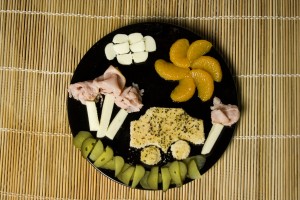Play with your child’s food
Innovating Children’s Lunchbox
As a child, I always served my plate trying to keep it harmonious, usually relying a lot on symmetry and the color and shape of each food item to create designs that would be as carefully eaten.
Today, looking for inspiration for my book, I found a blog with an innovative idea that made me relive my old habit – now turned into a passion for all things pretty in the kitchen.
In “An American in Bento”, Kashmirkat brings together the “ready-to-eat-lunch-in-a-box” philosophy and the care for aesthetics found in some fares of the Asian cuisine to prepare picturesque lunches using American staples for her husband.
In her first post, Kashmirkat tells us that her inspiration came from her daughter, who had been packing bento lunches for herself for 6 months. Such revelation made me think that, with layouts like the ones she arranges, children would look forward to tackle their lunch. Think of yourself as a child, knowing your mom prepared your meal with a special design. How eager would you be to open up that lunchbox?
Making it Fun With Cooking Tools (or Cooking Toys)
Like so many children (and my own husband) Kashmirkat’s husband has very specific preferences. To play with her sometimes restrictive palette, she uses creativity, coming up with different pictures each day.
Among the staples found in her photos, we often see macaroni salad as a background, decorated with flower-shaped carrots
, green beans as grass or leaves, and ham-and-cheese pinwheels as accents. What really called my attention, though, was the shape she gives boiled eggs
.

I had never before seen such things, and I envision it as a clever way to make healthy food fun: she uses molds to boil eggs into cars, fish, stars, pumpkins…
Children’s experience of the world happens mostly through play; that’s their default mechanism for absorbing and understanding what they go through, and that’s their main language for communicating it back. It seems logic to think that incorporating a playful presentation of healthy meals may have the power to reach a child’s will to experiment different flavors and textures.
Keeping the Balance
The key, in my opinion, is to keep balance. I mention that because I have seen disproportionately bounty lunches sent to children at school. An adult-sized bento can be overwhelming and trigger rejection rather than pleasure.
Keeping in mind the child’s needs for vitamins, carbohydrates, protein, and healthy fats is a useful blueprint for assembling an appropriate, well-proportioned, fun picture-lunch.
Daily recommended amount of each group for a 1000-calories diet (recommended intake for an average preschool child)
Personal Eating Rituals
Have you ever noticed how you eat your m&m’s? Have you ever asked your friends? Well, I have. My husband grabs a handful, pops them all in his mouth and chews them right away, already reaching for the next handful. I, on the other hand, put one at a time in my mouth, then I bite the edges of the sugary crust to open the candy in two separate shells. Next, I lick the smooth chocolate from each side. Finally, I chew the crusts. I love the thin crunch they have when the filling is gone!
We develop these particular rituals as we come in contact with different types of food, and some foods more than others compel us to explore.
An American Bento of my Own
That brings us back to the American bentos, that with its beauty and variety invite us to play with our food… Inspired on that idea and using the “My Pyramid” guidelines for a preschool child, I prepared the meal below. It has 1/2 oz of grains in the form of whole wheat white bread cut in the shape of a car, 2 tablespoons vegetables (the grassy pickled cucumber), 2 tablespoons fruit in the sunny tangerines, and 1/2 cup milk represented by the cheese string cut up to form the flower stems and the cloud. For meat, I used oven roasted ham. Look at the result below. How would you go about eating it?

My very first bento!
In time: If your child eats lunch at home, instead of presenting lunch in a box, how about bringing back the plate cover, still used in some 5-star restaurants to add excitement to the meal?

No comments.